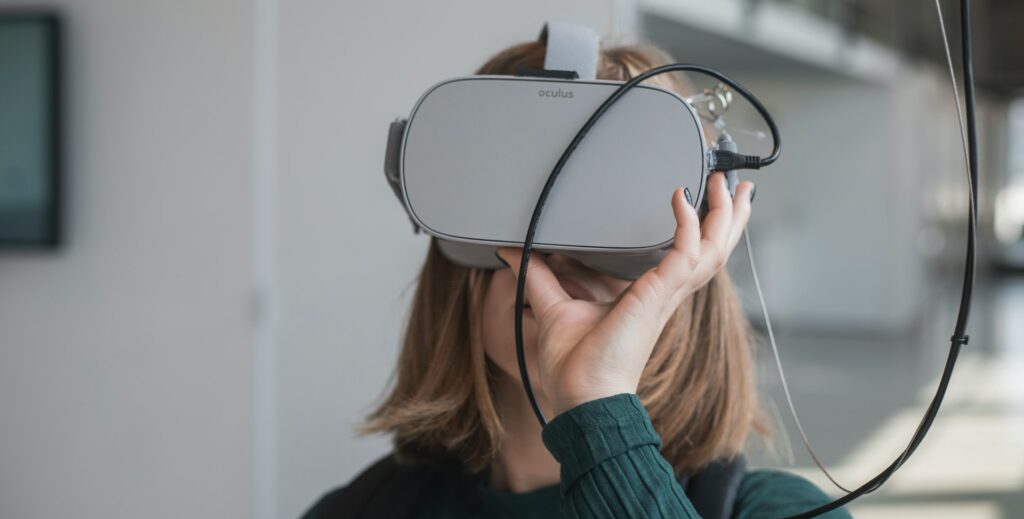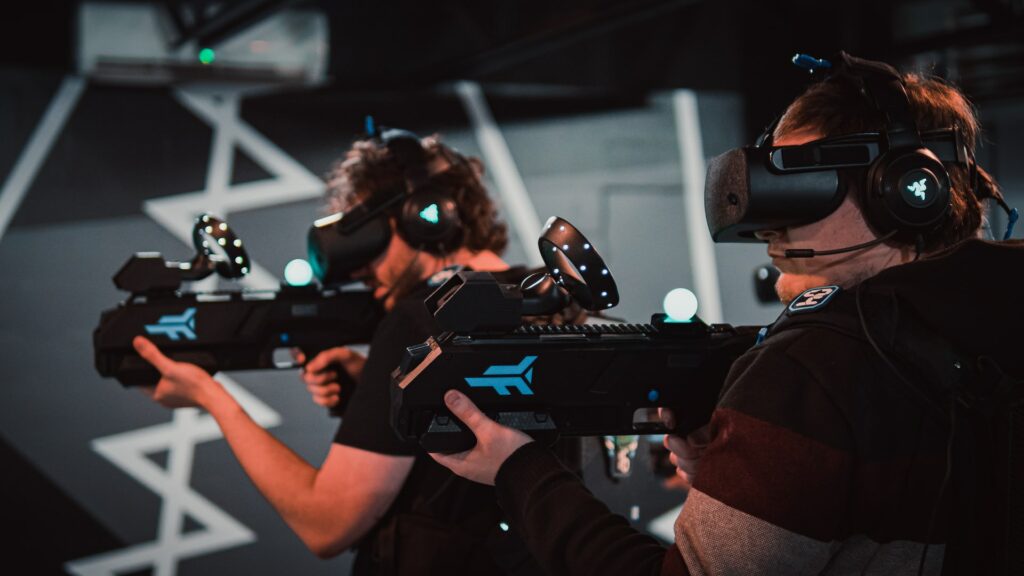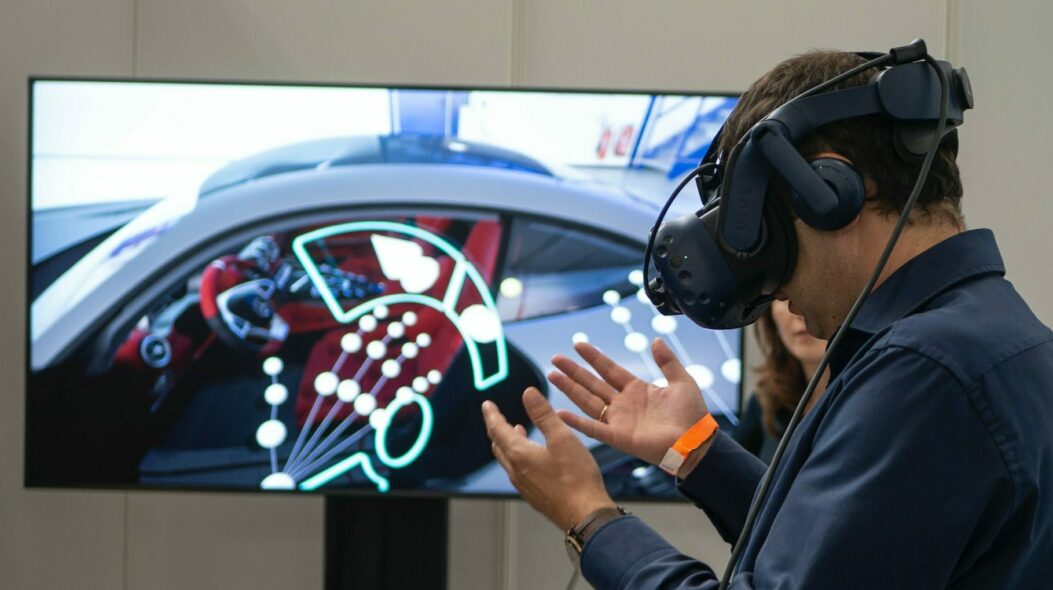The concept of the metaverse has been gaining traction in recent years, with major tech companies like Meta (formerly Facebook) investing heavily in its development. But what is the metaverse, and why is it such a big deal for creators?
In simple terms, the metaverse can be described as a virtual world that exists parallel to the physical world. It is a fully immersive, interactive environment that can be accessed through virtual reality (VR) and augmented reality (AR) technologies.
In this article, we will explore the meaning of the metaverse, its potential applications in VR, and the opportunities it presents for creators. We will also address some of the concerns and challenges associated with the metaverse, and offer tips for creators who want to take advantage of this emerging technology.

Photo by Maxim Hopman on Unsplash
What is the Metaverse?
The term “metaverse” was coined by science-fiction author Neal Stephenson in his 1992 novel “Snow Crash.” In the book, the metaverse is a virtual reality universe where people can interact with each other and digital objects in a fully immersive environment.
Today, the term has been adopted by the tech industry to describe the next evolution of the internet – a fully immersive, interactive environment that can be accessed through VR and AR technologies. The metaverse is essentially a collection of virtual worlds that are interconnected, allowing users to move freely between them and interact with each other in real-time.
Applications of the Metaverse in VR
One of the most promising applications of the metaverse is in VR. Virtual reality technology has come a long way in recent years, and the metaverse could take it to the next level by creating fully immersive, interactive environments where users can engage with each other and digital objects in real-time.
Some of the potential applications of the metaverse in VR for creators include:
- Social Media – Social media platforms like Meta have already started investing in the metaverse, with the goal of creating a fully immersive social media experience that goes beyond text and images.
- Education – The metaverse could revolutionize the way we learn by creating fully immersive educational environments that allow students to interact with each other and digital objects in real-time.
- Architecture and design – The metaverse can be used as a tool for architects and designers to create virtual models of buildings and structures. This allows architects to visualize their designs in a fully immersive environment and make adjustments before construction begins. The metaverse can also be used for interior design, allowing designers to create virtual representations of rooms and spaces to showcase their work to clients.
- Virtual merchandise stores – The metaverse can also be used as a platform for influencers and content creators to sell merchandise to their followers. Virtual stores can be set up within the metaverse, allowing followers to browse and purchase items such as clothing, accessories, and digital products. This can provide a new revenue stream for creators, as well as a way to deepen their engagement with their audience.
- Virtual brand activations – The metaverse can be used as a tool for brands and content creators to create virtual brand activations. Brands can sponsor virtual events, experiences, or spaces, allowing creators to showcase their products or services to their followers in an immersive and engaging way.
- Gaming – The gaming industry has already started exploring the potential of the metaverse, with games like Fortnite and Roblox incorporating metaverse-like features into their gameplay.

Photo by Maxime Doré on Unsplash
These are just a few examples of how the metaverse can be applied in VR. As the technology continues to evolve, new applications and use cases are likely to emerge, providing creators with even more ways to engage with their audience and monetize their content in the metaverse.
Opportunities for Creators in the Metaverse
The metaverse presents a huge opportunity for creators of all types, from game developers to artists and musicians. Some of the opportunities the metaverse presents include:
- New revenue streams – The metaverse offers creators a range of new opportunities to monetize their content. For example, creators can sell virtual items or experiences, such as clothing or accessories for avatars, or access to virtual events or concerts. Creators can also charge for access to their virtual spaces or experiences, such as games or educational programs. The metaverse allows creators to generate revenue from a global audience, creating new possibilities for growth and profitability.
- Increased exposure – The metaverse provides creators with a new platform to showcase their work to a global audience. Creators can reach users from around the world, building a larger following and increasing their exposure. In addition, the immersive nature of the metaverse allows creators to create more engaging and interactive experiences for their audiences. This can help to attract new fans and followers, and build a loyal community around their work.
- Collaborative opportunities – The metaverse allows creators to collaborate with each other in real-time, opening up new possibilities for creative collaboration. Creators can work together to build virtual environments or create shared experiences, such as virtual performances or exhibitions. Collaboration in the metaverse can also lead to new forms of creative expression, as creators from different disciplines work together to create new and innovative content. This can lead to new opportunities for creators to grow and develop their skills, and build valuable connections within the creative community.
- New forms of creative expression – The metaverse presents an opportunity for creators to explore new forms of creative expression that were not possible before. For example, artists can create 3D sculptures that can be viewed from all angles, musicians can create immersive audio experiences, and writers can create interactive stories that allow readers to explore different paths and outcomes.
- Enhanced audience engagement – In the metaverse, creators can engage with their audiences in new and exciting ways. For example, they can host virtual events such as concerts, exhibitions, and meet and greets, where fans can interact with them in real-time. Creators can also create interactive experiences that allow audiences to engage with their content in a more meaningful way, increasing audience engagement and loyalty.
Challenges and Concerns
While the metaverse presents exciting opportunities for creators, there are also some concerns and challenges that need to be addressed. Some of these include:
- Privacy and security – As with any online environment, there are concerns around privacy and security in the metaverse. Users may be sharing personal information within the virtual environment, such as their location, interests, and preferences. This information could be used for targeted advertising or other purposes. In addition, there are concerns around cyberattacks, hacking, and other security threats in the metaverse. Creators should take steps to protect their own data and the data of their users, such as using secure networks and implementing strong security protocols.
- Accessibility – The metaverse has the potential to exclude those who don’t have access to the necessary technology, creating a digital divide. Not all users may have access to VR or AR devices, or the high-speed internet connection required to access the metaverse. This could limit opportunities for creators who want to reach a wider audience, and could prevent some users from accessing important educational or cultural resources. In addition, there are also concerns around the accessibility of the metaverse for people with physical disabilities, mobility challenges, or neurodivergent conditions. Virtual reality and augmented reality technologies can be especially challenging for people with sensory impairments or difficulties with spatial awareness, and the immersive nature of the metaverse may exacerbate these challenges. For example, users with hearing impairments may struggle to navigate virtual environments that rely heavily on audio cues, while users with visual impairments may struggle to interact with digital objects that are designed primarily for visual interfaces. Users with mobility challenges may find it difficult to navigate virtual environments that require extensive movement or fine motor control, while users with neurological conditions may experience sensory overload or disorientation in the immersive environment of the metaverse. Creators should be aware of these accessibility issues and work to make their content inclusive, accessible and available to as wide an audience as possible.
- Monopolization – There are concerns that major tech companies like Meta could monopolize the metaverse, limiting opportunities for smaller creators. These companies may have significant resources and expertise, allowing them to dominate the metaverse and control the distribution of content within it. This could lead to a concentration of power and influence within the hands of a few companies, limiting the diversity and creativity of the metaverse. Creators should be aware of these risks and work to ensure that the metaverse remains an open and diverse platform for creative expression. This may involve advocating for policies that promote competition and innovation within the metaverse, or exploring alternative platforms and technologies that offer greater independence and autonomy for creators.
- Copyright infringement – The metaverse raises concerns about copyright infringement, as users can create and distribute their own content within the virtual environment. Creators may need to take additional steps to protect their intellectual property rights in this new environment, such as watermarking or licensing their content.
- Addiction and mental health – As with any technology, there are concerns that the metaverse could be addictive and have negative effects on mental health. Spending extended periods of time in a virtual world may lead to a sense of disconnection from reality and contribute to social isolation. Creators should be aware of these risks and take steps to ensure that their content promotes healthy use of the metaverse.
Conclusion
As the metaverse continues to evolve and gain popularity, it’s clear that it will play an increasingly important role in shaping the future of online interactions and experiences. For creators, the metaverse presents a range of exciting opportunities to explore new forms of creative expression, reach wider audiences, and monetize their content in new and innovative ways. However, the metaverse also presents challenges and concerns around privacy, accessibility, and monopolization, which must be addressed in order to ensure that it remains an open and diverse platform for creativity and innovation.
One tool that could be especially useful for influencers and content creators looking to navigate the metaverse is Wizlink, a link-in-bio tool that could serve as a virtual ID showcasing essential content and information within easy reach of their audience in the virtual world. By using Wizlink, creators could direct their audience to a mobile landing page that features links to their social media accounts, merchandise, and other important information. This can help to increase their visibility and reach in the metaverse, while also making it easier for their audience to engage with their content and stay up-to-date on their latest projects and offerings. As the metaverse continues to grow and evolve, tools like Wizlink will become increasingly valuable for creators looking to build their brand and engage with their audiences in this exciting new frontier.






